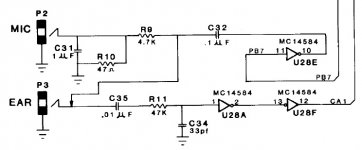SiriusHardware
Veteran Member
Good to know it's a cassette thing. I thought it was actual data being transmitted, I'm not very familiar with the Kansas city standard format.
--Christoffer
As audio recorders can only really deal with audio, cassette interfaces typically output either a single tone and silence to represent logic 1 and logic 0 respectively, or long and short bursts of a single tone with long and short representing one logic state or the other, or a continuous stream of two tones - a high tone to represent one logic state and a low tone to represent the other logic state. Not sure which of those schemes your unit will use. The lead-in tone doesn't normally contain significant data, it's just there to give the recording circuit something to measure and adjust itself to before the real data starts flowing.
Incidentally, I don't see your image / schematic for the interface anywhere in your previous posts, or is that just me? I would have been interested to see it.

